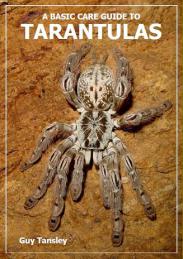
Of the seven described species of Pterinochilus Pocock, 1897, three are commonly found in the hobby. All can be kept under similar conditions (terrestrial set-up is ideal) - as they prefer drier conditions, the tank can be
allowed to dry out somewhat although a water dish should be made available. A deep substrate will allow for burrowing but most will fill their container with thick silk and all breed readily in
captivity (see here for more info on housing). Defensive in nature,
they will assume the threat position without much provocation and some experience should be gained before purchasing.
Common species in captivity:
P. chordatus (Gerstäcker, 1873) - East Africa
A medium sized terrestrial baboon spider, P. chordatus is relatively easy to
maintain in captivity. If supplied with a cork bark retreat, specimens will seldom be seen as they burrow extensively and lay down copious amount of silk in their enclosures. Breeding is straight
forward with a responsive female but males may be attacked and killed after palp insertion. P. chordatus grows reasonably fast and they are good feeders, taking prey much larger than themselves. Originating from East Africa, their enclosures can be allowed to dry out occasionally but a
water dish should be made available at all times. Increased humidity is recommended during pre-moult. Overall colouration is black and brown with a symmetrically spotted abdomen (there are several
colour variations, see gallery for more examples.). The legs are banded
with yellow and the carapace has the typical Pterinochilus starburst pattern
although less obvious than in P. murinus. Freshly moulted males can
be quite striking having a distinct blue colouration to the femurs. Captive bred stock should be available. Medium sized species reaching up to 12 cm legspan.
P.
lugardi Pocock, 1900 - Southern, East Africa
With its pale colouration, P. lugardi is easily distinguished from others in the genus. Not as defensive
as P. murinus but not recommended for handling all the same. Smaller in size reaching around 10
cm legspan and can be housed as P. chordatus and P. murinus. Regularly imported and breeds freely in captivity so should be readily available
at a reasonable cost.
P.
murinus Pocock, 1897 - Angola, Central, East, Southern Africa
A typical terrestrial set-up will suffice. Provide a cork bark retreat and slightly moist substrate. P.
murinus is an opportunistic burrower and will sometimes fill the entire container with thick layers of silk. Captive bred stock is available as this
species adapts well to captivity and is easy to breed. Males posses tibial hooks and mating is straight forward given a receptive female. After mating the female should be fed as much as she will
take and after approximately eight to ten weeks the eggsac is produced. A typical P. murinus eggsac is suspended in a
hammock-like web surrounded by thick layers of silk. The female seals herself inside this web and should not be disturbed during the incubation period of around six to eight weeks. The spiderlings
emerge fully mobile and number around 150. They can be left with the female for several weeks but should be separated to prevent cannibalism. P.
murinus is attractively marked with a golden starburst pattern on the carapace and a symmetrically spotted and striped abdomen. The overall colour is
russet brown and this species is particularly defensive and will readily bite. Not recommended for the beginner but a hardy species, living approximately eight to ten years in captivity. A second egg
sac is sometimes produced from a single pairing but this is usually smaller than the first and contains less young. The cage can be allowed to dry out occasionally but it is recommended to increase
humidity during stressful times such as moulting and egg sac production. Spiderlings grow rapidly and can reach maturity in under two years. An ideal 'first' African baboon. There are several colour
forms of P. murinus available and this includes the red colour form (Usambara or rcf). These variants
are regional colour forms and care should be taken not to hybridise them. Medium sized species reaching up to 12 cm legspan.

